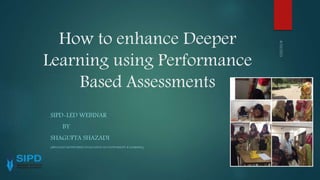
How to enhance Deeper Learning using Performance Based Assessments
- 1. How to enhance Deeper Learning using Performance Based Assessments SIPD-LED WEBINAR BY SHAGUFTA SHAZADI (SPECIALIST MONITORING EVALUATION ACCOUNTABILITY & LEARNING)
- 3. What is “DEEPER LEARNING”?
- 7. As an educator do we promote deeper learning? Do we teach children about their career, life skills i.e. taking out loans, buying a house, budgeting, investments, saving, decision making etc? How can we prepare our students for their future career in an era which is rapidly changing?
- 8. Performance based assessments to promote deeper learning PBA is according to Educational Testing “A test in which a test taker actually demonstrates the skills the test is intended to measure by doing real-world tasks that require those skills, rather than answering questions asking how to do them” According to (Mc Mellon, 2007), teacher observes and makes judgments about students demonstration of a skill in creating a product or presentation
- 9. PBAs can be process oriented or product oriented Product Oriented Based on final work produced by students using multiple levels of metacognition. Depicts the application of knowledge. Demonstrates the levels of task achievement. Examples: projects, art, portfolio, photo, writing samples (newspaper articles, poetry/essay essays) The assessment is done on the basis of the final product
- 10. Process Oriented Insight to students’ thinking, reasoning, motivation. Examples: Individual or pair conferences, presentations, surgeries, course designing, Role play Assessment has to be done during the performance of the task-when the student is demonstrating the skills.
- 11. Why Performance Based Assessment
- 12. Why performance based assessments? Engages and Measures what it’s really matters in the life outside the classroom Creating opportunities to equip students the necessary skills to thrive in 21st century More like instructional activity than like paper pencil tests When students experience PBA there is some learning takes place
- 13. Discourages memorize and regurgitate content and measures higher-order thinking skills. Bringing students out of their comfort zone Engage them in exploration, solve real life problems Create opportunities for global collaboration Make them think rethink and learn
- 14. Examples of PBA Tasks Task: Working in pairs. Making seed balls/ earth balls/ clay dumplings using fertile clay. (note) write a list of questions you come across while doing the work Material: clay, natural fertilizer, water, any seeds, tub, gloves, Directions: Mix the soil, clay and 1 part water thoroughly. There shouldn’t be lump Take small bits of the clay mixture and roll into ball about 1 inch diameter Add seed Dry seed balls for 24-48 hours in a shady place before sowing or restoring Cast out into fields at the appropriate time of the year Philosophy and science: to make the surround greener, more environmental friendly place. Useful to employ in urban areas where tillage is not an option. Establish perennial pasture on marginal degraded highlands where steep slopes, existing woodlands, shallow soils/exposed bedrock makes the use of seed drills and rippers impossible.
- 15. Performance Assessment Task Template.doc
- 16. TASK: Make a parallel circuit model using the material provided Material: wires, four 1.5 volt batteries, 3 bulbs, 4 switches, hard board, pencil, ruler Steps (note) Make predictions and write questions that hits your mind to think Gather the main components of a parallel circuit (provided already) Mark a diagram using pencil on board Point battery, wire, switch and bulbs at different points Prepare your wires according to the required length Connect the first lightbulb to the battery. Begin to connect the switch to the battery. Connect the switch to the first lightbulb. Connect all three bulbs in a way that is controlled by one switch Connect each bulb with its own switch
- 17. Theory: Current flows from positive to negative end of the battery. In parallel circuit there are more than one paths to flow current, therefore, each bulb has its path that when any one bulb goes off rest will still be glowing.
- 18. Circuit diagram Assessment Checklist S# Steps Yes( 1) No(0) i Battery is placed rightly ii Switch is placed at positive end iii Bulbs are connected in a way that if one goes off the rest are still lighting up iv All the bulbs glow from main switch v Shown current direction from +ive to –ive vi Labelled components of circuit Exemplary questions be: 1. Why switch is placed at positive end? 2. Why domestic circuits are connected parallel? 3. Why if the one bulb goes off the rest are still lighting up?
- 19. Take away What can I do with what I know is more important than what do I know?
- 20. Q&As
